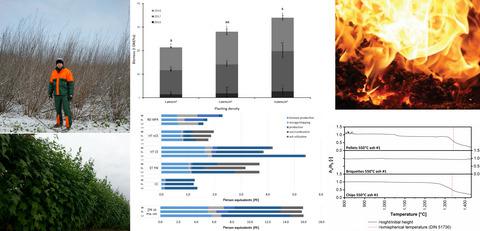当前位置:
X-MOL 学术
›
GCB Bioenergy
›
论文详情
Our official English website, www.x-mol.net, welcomes your
feedback! (Note: you will need to create a separate account there.)
Full assessment of Sida (Sida hermaphrodita) biomass as a solid fuel
Global Change Biology Bioenergy ( IF 5.9 ) Pub Date : 2020-06-16 , DOI: 10.1111/gcbb.12694 Nicolai D. Jablonowski 1 , Tobias Kollmann 2 , Martin Meiller 3 , Matthias Dohrn 4, 5 , Michael Müller 4 , Moritz Nabel 1, 6 , Petra Zapp 7 , Andreas Schonhoff 7 , Silvia D. Schrey 1
Global Change Biology Bioenergy ( IF 5.9 ) Pub Date : 2020-06-16 , DOI: 10.1111/gcbb.12694 Nicolai D. Jablonowski 1 , Tobias Kollmann 2 , Martin Meiller 3 , Matthias Dohrn 4, 5 , Michael Müller 4 , Moritz Nabel 1, 6 , Petra Zapp 7 , Andreas Schonhoff 7 , Silvia D. Schrey 1
Affiliation

|
Due to an increased awareness of climate change and limited fossil resources, the demand for alternative energy carriers such as biomass has risen significantly during the past years. This development is supported by the idea of a transition to a bio‐based economy reducing fossil‐based carbon dioxide emissions. Based on this trend, biomass for energy is expected to be used in the EU mainly for heating until the end of the decade. The perennial herbaceous mallow plant Sida hermaphrodita (L.) Rusby (‘Sida’) has high potential as an alternative biomass plant for energy purposes. Different density cultivation scenarios of Sida accounting for 1, 2, or 4 plants per m2 resulted in a total biomass yield of 21, 28, and 34 tons dry matter/ha, respectively, over a 3‐year period under agricultural conditions while the overall investment costs almost doubled from 2 to 4 plants per m2. Subsequently, Sida biomass was used as SI) chips, SII) pellets, and SIII) briquettes for combustion studies at pilot plant scale. Pellets outcompeted chips and briquettes by showing low CO emission of 40 mg/Nm3, good burnout, and low slagging behavior, however, with elevated NOx and SO2 levels. In contrast, combustion of chips and briquettes displayed high CO emissions of >1,300 mg/Nm3, while SO2 values were below 100 mg/Nm3. Contents of HCl in the flue gas ranged between 32 and 52 mg/Nm3 for all Sida fuels tested. High contents of alkaline earth metals such as CaO resulted in high ash melting points of up to 1,450°C. Life cycle assessment results showed the lowest ecological impact for Sida pellets taking all production parameters and environmental categories into consideration, showing further advantages of Sida over other alternative biomasses. Overall, the results indicate the improved applicability of pelletized Sida biomass as a renewable biogenic energy carrier for combustion.
中文翻译:

全面评估作为固体燃料的Sida(Sida hermaphrodita)生物质
由于人们对气候变化的意识增强,化石资源有限,因此对生物质等替代能源载体的需求在过去几年中显着增加。向减少基于化石的二氧化碳排放的生物经济过渡的想法支持了这一发展。基于这一趋势,预计到本世纪末,用于欧盟的能源生物质将主要用于取暖。多年生草本锦葵植物Sida hermaphrodita(L.)Rusby('Sida')作为替代生物质植物具有很高的潜力,可用于能源目的。Sida的不同密度栽培方案每m 2占1、2或4种植物在农业条件下,三年期间的总生物量产量分别为21、28和34吨干物质/公顷,而总投资成本从每m 2 2到4株几乎翻了一番。随后,将Sida生物质用作SI)碎片,SII)颗粒和SIII)团块,用于中试规模的燃烧研究。通过显示40 mg / Nm 3的低CO排放,良好的燃尽性和低的结渣行为,小球与木屑和团块竞争,但NO x和SO 2含量升高。相反,木片和煤球的燃烧显示出较高的CO排放,其> 1,300 mg / Nm 3,而SO 2值低于100 mg / Nm 3。对于所有测试的Sida燃料,烟道气中的HCl含量在32至52 mg / Nm 3之间。高含量的碱土金属(如CaO)导致高达1,450°C的高灰熔点。生命周期评估结果显示,考虑到所有生产参数和环境类别,Sida颗粒对生态的影响最小,这表明Sida较其他替代生物质具有更多优势。总体而言,结果表明粒状Sida生物质作为可再生生物能源载体燃烧的适用性得到改善。
更新日期:2020-06-16
中文翻译:

全面评估作为固体燃料的Sida(Sida hermaphrodita)生物质
由于人们对气候变化的意识增强,化石资源有限,因此对生物质等替代能源载体的需求在过去几年中显着增加。向减少基于化石的二氧化碳排放的生物经济过渡的想法支持了这一发展。基于这一趋势,预计到本世纪末,用于欧盟的能源生物质将主要用于取暖。多年生草本锦葵植物Sida hermaphrodita(L.)Rusby('Sida')作为替代生物质植物具有很高的潜力,可用于能源目的。Sida的不同密度栽培方案每m 2占1、2或4种植物在农业条件下,三年期间的总生物量产量分别为21、28和34吨干物质/公顷,而总投资成本从每m 2 2到4株几乎翻了一番。随后,将Sida生物质用作SI)碎片,SII)颗粒和SIII)团块,用于中试规模的燃烧研究。通过显示40 mg / Nm 3的低CO排放,良好的燃尽性和低的结渣行为,小球与木屑和团块竞争,但NO x和SO 2含量升高。相反,木片和煤球的燃烧显示出较高的CO排放,其> 1,300 mg / Nm 3,而SO 2值低于100 mg / Nm 3。对于所有测试的Sida燃料,烟道气中的HCl含量在32至52 mg / Nm 3之间。高含量的碱土金属(如CaO)导致高达1,450°C的高灰熔点。生命周期评估结果显示,考虑到所有生产参数和环境类别,Sida颗粒对生态的影响最小,这表明Sida较其他替代生物质具有更多优势。总体而言,结果表明粒状Sida生物质作为可再生生物能源载体燃烧的适用性得到改善。











































 京公网安备 11010802027423号
京公网安备 11010802027423号